Fujifilm XF 35mm F2 R WR Review

Introduction
The Fujifilm XF 35mm F2 R WR is a new compact standard prime lens for Fujifilm’s X-series compact system cameras. The dust- and weather-proof Fujifilm XF 35mm F2 R WR lens offers an angle-of-view equivalent to a 53mm lens in a 35mm system, similar to that of the human eye, and a bright f/2 maximum aperture for low-light shooting. Other highlights include an iris diaphragm with nine rounded blades, an aperture ring on the metal lens barrel, Super EBC coating for improved optical performance, fast auto-focusing of 0.08 sec, and an optical formula that comprises 9 elements in 6 groups, including 2 aspherical elements. The Fujifilm XF 35mm F2 R WR lens is currently available for £299.99 / $449.95 in the UK and the US, respectively.
Ease of Use
The Fujifilm XF 35mm F2 R WR is a compact prime lens, weighing 170g and measuring 60mm in length, which is a little lighter and shorter than the older XF 35mm F1.4 R lens. As you can see in the pictures below, it complements the top-of-the-range Fujifilm X-T1 very well, not feeling at all front-heavy and more than matching the body in terms of its build quality.
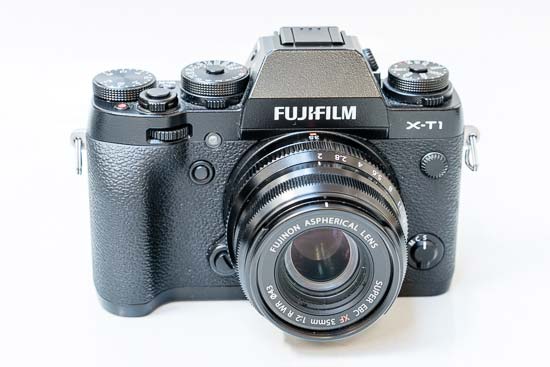 The Fujifilm XF 35mm F2 R WR lens attached to the Fujifilm X-T1 camera
The Fujifilm XF 35mm F2 R WR lens attached to the Fujifilm X-T1 camera
 The Fujifilm XF 35mm F2 R WR lens attached to the Fujifilm X-T1 camera
The Fujifilm XF 35mm F2 R WR lens attached to the Fujifilm X-T1 camera
 The Fujifilm XF 35mm F2 R WR lens attached to the Fujifilm X-T1 camera
The Fujifilm XF 35mm F2 R WR lens attached to the Fujifilm X-T1 camera
The Fujifilm XF 35mm F2 R WR lens boasts a metal mount, high-grade metal barrel and non-rotating 43mm filter thread. The focus ring is wide enough given the overall size of the lens, smooth in action without being loose, and has a ridged, rubberised grip band. There are no “hard stops” at either end of the 35cm-infinity focus range though.
 The Fujifilm XF 35mm F2 R WR lens alongside the Fujifilm X-T1 camera
The Fujifilm XF 35mm F2 R WR lens alongside the Fujifilm X-T1 camera
 Side of the Fujifilm XF 35mm F2 R WR lens
Side of the Fujifilm XF 35mm F2 R WR lens
 Front of the Fujifilm XF 35mm F2 R WR lens
Front of the Fujifilm XF 35mm F2 R WR lens
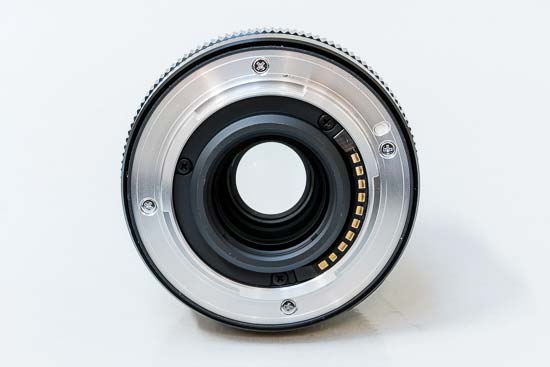 Rear of the Fujifilm XF 35mm F2 R WR lens
Rear of the Fujifilm XF 35mm F2 R WR lens
The Fujifilm XF 35mm F2 R WR lens has a traditional aperture ring on the lens barrel, which allows you to set the aperture in 1/3 steps, complete with full aperture markings on the lens barrel. The aperture is also shown in the viewfinder or on the LCD screen. The rather thin aperture ring is nicely damped and makes a distinctive click as you change the setting, although it's too easily moved when stored in a pocket or bag. The aperture ring toggles between auto aperture control (the ring is set to A) or manual aperture control (the switch is set to one of the aperture values).
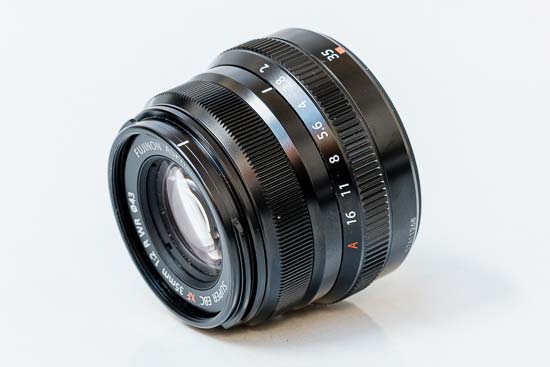 Front of the Fujifilm XF 35mm F2 R WR lens
Front of the Fujifilm XF 35mm F2 R WR lens
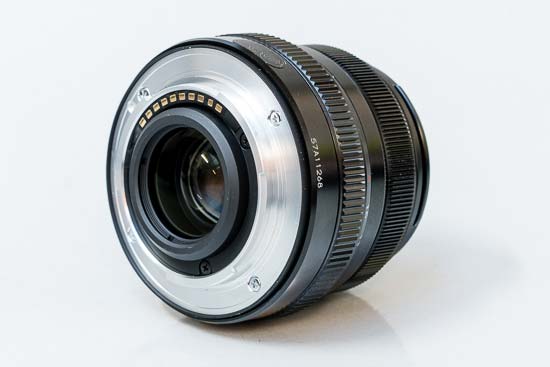 Rear of the Fujifilm XF 35mm F2 R WR lens
Rear of the Fujifilm XF 35mm F2 R WR lens
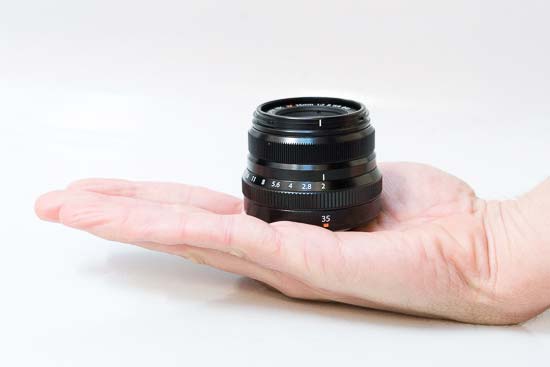 The Fujifilm XF 35mm F2 R WR lens in-hand
The Fujifilm XF 35mm F2 R WR lens in-hand
 The Fujifilm XF 35mm F2 R WR lens with the supplied lens hood fitted
The Fujifilm XF 35mm F2 R WR lens with the supplied lens hood fitted
In terms of accessories, the lens ships with a tiny plastic circular-shaped lens hood and a soft lens bag. A more classical metal hood (LH-XF35-2) is also available for purchase as an optional accessory.
Focal Range
The Fujifilm XF 35mm F2 R WR lens has an angle of view of 44.2 degrees.

Distortion
The Fujifilm XF 35mm F2 R WR doesn't exhibit any barrel distortion, as you can see in the photo below, and vignetting is very well-controlled too even wide-open at f/2.

Focusing
The Fujifilm XF 35mm F2 R WR lens has an internal focusing (IF) system with a near-silent stepping motor. In practice, we found the auto-focus to be fast and accurate on the X-T1 body. Thanks to the IF mechanism the front of the lens does not rotate on focus, which is very good news for anyone looking to use the lens in conjunction with a polariser or graduated neutral density filter.
Chromatic Aberrations
Chromatic aberrations, typically seen as purple or blue fringes along contrasty edges, are not really a problem with the Fujifilm XF 35mm F2 R WR lens, as shown in the example below.
 |
Macro
The Fujifilm XF 35mm F2 R WR is not a macro lens, with the close-focus point at 35cm from the sensor plane and a maximum magnification of 0.135x. The following example illustrates how close you can get to the subject, in this case a CompactFlash card.
 Close-up Performance
Close-up Performance
Bokeh
Bokeh is a word used for the out-of-focus areas of a photograph, and is usually described in qualitative terms, such as smooth / creamy / harsh etc. Fujifilm have paid attention to this aspect of lens use, employing a 9-segment diaphragm with rounded blades for pleasing bokeh. In our view, their efforts have been very successful for a standard prime lens - see the examples below.
 |
 |
 |
 |
Sharpness
In order to show you how sharp this lens is, we are providing 100% crops on the following page.
